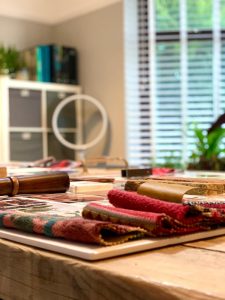Welcome to the next stage in our design series. This post is all about Mood Boards. This is the natural progression after the client brief stage.
The Mood Board step is crucial in the design process. It marries our ideas as the designer with the clients to produce one cohesive aesthetic. All without having done a single thing in the space. It is, essentially, a compilation of design inspiration to ensure a clear understanding of the direction in which the project is going.
It’s how you gauge whether both client and designer are on the same page.
A physical mood board provides the opportunity to showcase the design concept and for the client to see images of spaces which feature elements of the scheme. Everything which makes up the concept is considered and displayed i.e. the materials that will be used, the lighting, the fabric of the furniture, the colour of the accents, wall finishes, floor finishes, lifestyle images, graphics and signage, right down to the knobs on the drawers or handles on the cupboards.
We favour, and will always suggest, a physical mood board to put in front of the client. You can touch, feel and see every element of the space. It really helps the client to visualise the space and to get the level of detail we go to but it also allows us as the designers to really develop the design and anticipate what the customer will experience.


